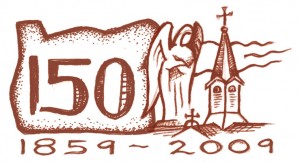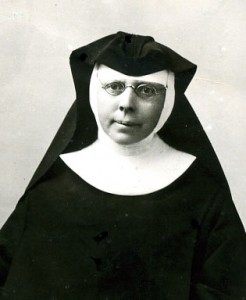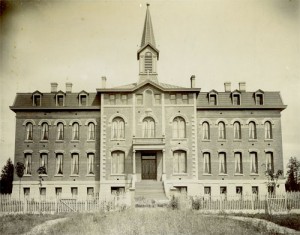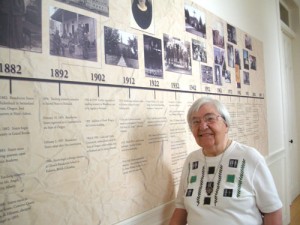This is a continuation of a year-long series of stories about historical people and institutions of our region, which Our Town is publishing in commemoration of Oregon’s Sesquicentennial.
By Linda Whitmore
Religion is an integral part of the story of Mt. Angel and surrounds. Among institutions established in the region’s early white settlement is Queen of the Angels Monastery. The community of Benedictine sisters continues today, serving the broader community as needs arise.
The history of local monastic society begins in Switzerland and the sisters’ outreach was evident from the beginning.
“Throughout Europe, governments were closing monastic houses down,” said Sr. Alberta Dieker, monastery archivist and historian. “So the abbot of Engelberg (Switzerland) thought it would be good to establish a monastic house in America, in case the house would be closed.”
A contingent of monks was sent to Conception, Mo., to build a center there. However, Father Adelhelm Odermatt wanted a place more like Engelberg, so he came to the West Coast looking for a new site. At the same time, Archbishop Seghers of Portland needed priests with language skills to serve the French-speaking Catholics in French Prairie and German-speaking residents of Sublimity and Fillmore, the former name of Mt. Angel. Father Adelhelm’s Swiss-born priests could fill that need and he liked the area. “Now, the monks wanted sisters to teach the children and also to do the cooking and housekeeping for the monks,” said Sr. Alberta. So Father Adelhelm traveled back to Maria Rickenbach, Switzerland; where he asked for sisters to come to America with him.
Head sister Bernardine Wachter, four or five other sisters and some postulants agreed, first going to Conception, Mo., then across country, arriving in Marion County on Oct. 30, 1882.
“The sisters had been promised a nice convent in Gervais, but there was nothing,” said Sr. Alberta, so they were housed in a saloon. There they made their home and started a school.
“By 1885 or ’86, the sisters still living in the (saloon-turned) school needed to build a separate housing and chapel,” said Sr. Alberta. “There’s a very charming story about how the monks (of Mt. Angel’s abbey) invited them over here for a picnic.”
It was a turning point. The lovely day in an orchard got them thinking about building their home base here. They were able to obtain the property and construction began in 1886 for Queen of the Angels Monastery.
The core building was finished in 1888, with a north wing added in 1903 and south wing in 1912 as the number of students at their academy increased. They operated a boarding school, high school and college, known as Mt. Angel Academy and College – the town had changed its name in 1893 from Fillmore to Mt. Angel, in reference to Engelberg, Switzerland; where Father Adelhelm came from.
The sisters extended their outreach in schools throughout the Willamette Valley. Some of the sisters established a mission school for American Indians in Grande Ronde and others went British Columbia to teach the native population.
The religious community expanded as postulants from Europe and women from the local region joined them. At the peak, there were about 120 sisters who called Queen of the Angels Monastery their home.
“For the first 75 years at least, many of the sisters were teachers,” said Sr. Alberta. Some taught at schools in Oregon City, Woodburn, Eugene and Portland during the school year and returned to Mt. Angel for the summer.
“What distinguishes our monastic way of life is living in community, our prayer together and the stability of this as our home base,” said Sr. Alberta. It’s always home – those who take assignments elsewhere come back to retire.
Changing times have changed the monastery’s focus. In 1900, the government took over operation of schools on reservations and in the mid-1900s, the need for Catholic educational facilities in Mt. Angel declined with the growth of public elementary and high schools, and the college closed in 1973.
In the meantime, other needs in the town became evident. In 1957, at the request of the local community, the sisters established the Benedictine Nursing Center, which they operated until transferring it to the Providence Health Care System in 1998.
The former academy buildings were put to new uses. The college administration building became Shalom Prayer Center, and is used for retreats. It also has a gift shop with a selection of spiritual books, as well as the mustard made by the sisters to help support their programs.
Former dormitories became St. Joseph Shelter, housing migrant workers and homeless families since the 1980s. Downstairs is Mission Benedict, proving food boxes, clothing and emergency assistance on Fridays from 1 to 4 p.m. The former student commons is leased to the Fr. Bernard Youth Center.
In addition to changes seen in the sisters’ focus of service, there have been changes in the campus. A major earthquake in 1993 damaged several of the buildings. The four-story academy building known as Howard Hall, had to be demolished. A new chapter room was built for meetings and the chapel dedicated in 1998 looks out to the grounds and gardens.
“This is our home, so it’s very important that it’s a beautiful space and a space that is conducive to a contemplative life,” said Sr. Alberta.
Doors, alcoves, sconces and other parts of the old buildings were reused in the new facilities, blending old and new.
As the sisters strive to meet changing needs of the community, they look to a future of fulfillment. While some of their ranks are aging, the sisters are adding new postulants to the religious community.
“We shall continue to live together and pray together and take care of needs as they arise,” Sr. Alberta said. “We continue our main work in the school of the Lord’s service.”